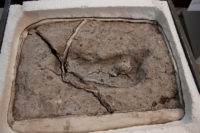 A human footprint discovered at the archaeological site of Pilauco in Patagonia, southern Chile, has been dated to 15,600 before the present, making it the oldest ever found in the Americas. The print was first discovered in 2010 by a student at the Universidad Austral of Chile in an excavation grid that also contained megafauna bones, wood and plant remains and lithic tools. Researchers then spent nearly a decade dating the fossil and confirming that it was left by a person.
A human footprint discovered at the archaeological site of Pilauco in Patagonia, southern Chile, has been dated to 15,600 before the present, making it the oldest ever found in the Americas. The print was first discovered in 2010 by a student at the Universidad Austral of Chile in an excavation grid that also contained megafauna bones, wood and plant remains and lithic tools. Researchers then spent nearly a decade dating the fossil and confirming that it was left by a person.
It wasn’t immediately clear from the print in situ that it was human. The dimensions were similar to other mammals like ground sloths, and there wasn’t a highly specific outline capturing human morphology from heel to toes. Paleontologists made a silicone cast of the print, X-rayed it, photographed it from different angles and documented the trace characteristics they observed. A mesh model was created and analyzed with 3D software.
The team painstakingly recreated possible scenarios for the formation of the footprint. The performed nine experiments with three different water contents and three human trackmakers with the same foot size but different heights and weights. Researchers built a box seven and a half feet long to hold sediment excavated from the layer near the footprint. As soon as the water was added, trackmakers stepped in the box. The prints they left were photographed with scale, the depths of each print at the big toe, heel and arch were measured and how much of the surface was flattened.
Comparisons of the experiment data and observed trace characteristics confirmed the footprint was indeed human. The print itself could not be directly dated, but radiocarbon testing of plant material and wood near the impression resulted in an estimated date of 15,600 years ago.
[Geologist Mario] Pino said the footprint appears to be that of a barefoot man weighing about 70 kilograms (155 pounds) and of the species Hominipes modernus, a relative of Homo sapiens.
The area in Chile has proven rich in fossils, including evidence of an ancestor of today’s elephants and American horses, as well as of more recent human presence.
An earlier footprint found at a site south of Osorno was found to be about 1,000 years more recent.
The section of sediment with the footprint was removed en bloc and placed in a glass box for long-term preservation at the Pleistocene Museum in the Parque Chuyaca, Osorno, Chile.
I have an unabashed love for footprint fossils, because footprints in the sand (or mud, or a swamp) are classic examples of the impermanence of life, and yet, when conditions are just right, instead of disappearing in seconds they turn to rock and are found thousands, even millions of years later. I’m always keen to relay a good fossilized footprint story, but this is the first time I recall encountering the scientific name for them: paleoichnites. Into the Scrabble lockbox it goes.